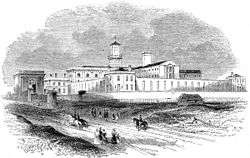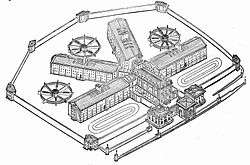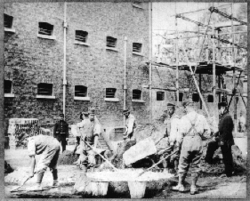HM Prison Pentonville
 Pentonville Prison in 1842 | |
| Location | Barnsbury, London |
|---|---|
| Security class | Adult Male/Category B&C |
| Population | 1308 (1 escaped) http://www.bbc.co.uk/news/uk-england-london-37899401(as of November 2016) |
| Opened | 1842 |
| Managed by | HM Prison Services |
| Governor | Kevin Reilly |
| Website | Pentonville at justice.gov.uk |
HM Prison Pentonville (informally "The Ville") is a Category B/C men's prison, operated by Her Majesty's Prison Service. Pentonville Prison is not actually within Pentonville itself, but is located further north, on the Caledonian Road in the Barnsbury area of the London Borough of Islington, north London, England.
History
The first modern prison in London, Millbank, opened in 1816. It had separate cells for 860 prisoners and proved satisfactory to the authorities who started building prisons to deal with the rapid increase in numbers occasioned by the ending of capital punishment for many crimes and a steady reduction in transportation.
Two Acts of Parliament allowed for the building of Pentonville prison, designed by Captain Joshua Jebb, Royal Engineers, for the detention of convicts sentenced to imprisonment or awaiting transportation. Construction started on 10 April 1840 and was completed in 1842. The cost was £84,186 12s 2d.

It had a central hall with five radiating wings, all visible to staff at the centre. This design, intended to keep prisoners isolated – the "separate system" first used at Eastern State Penitentiary in Philadelphia – was not, as is often thought, a panopticon. Guards had no view into individual cells from their central position. Pentonville was designed to hold 520 prisoners under the separate system, each having his own cell, 13 feet (4 m) long, 7 feet (2 m) wide and 9 feet (3 m) high with little windows on the outside walls and opening on to narrow landings in the galleries.[2]
They were "admirably ventilated", a visitor wrote, and had a water closet, though these were replaced by communal, evil-smelling recesses because they were constantly blocked and the pipes were used for communication.[2] The cost of keeping a prisoner at Pentonville was about 15 shillings a week in the 1840s.
Prisoners were forbidden to speak to each other and when out on exercise would tramp in silent rows, wearing brown cloth masks. In chapel, which they had to attend every day, they sat in cubicles, or "coffins" as the prisoners referred to them, their heads visible to the warder but hidden from each other.[3] The chaplains were very influential, making individual cell visitations, urging the convicts to reform, and supervising the work of the schoolmasters.[4]

Mental disturbances were common. An official report admitted that "for every sixty thousand persons imprisoned in Pentonville there were 220 cases of insanity, 210 cases of delusion, and forty suicides".[3] However, conditions were better and healthier than at Newgate and similar older prisons, and each prisoner was made to do work such as picking oakum (tarred rope) and weaving. The work lasted from six in the morning until seven at night.[3] The food ration was a breakfast of 10 ounces of bread and three-quarters of a pint of cocoa; dinner was half a pint of soup (or four ounces of meat), five ounces of bread, and one pound of potatoes; supper a pint of gruel and five ounces of bread.[3]
Pentonville became the model for British prisons; a further 54 were built to similar designs over six years and hundreds throughout the British Empire. For instance, Pentonville was used as a model for the eventual construction of Corradino Prison in Rahal Gdid, Malta by W. Lamb Arrowsmith in 1842.[5]
Execution site
Prisoners under sentence of death were not housed at Pentonville Prison until the closure of Newgate in 1902, when Pentonville took over executions in north London. Condemned cells were added and an execution room built to house Newgate's gallows. At the same time Pentonville took over from Newgate the function of being the training location for future executioners.
Irish revolutionary Roger Casement was hanged there on 3 August 1916 and his remains interred at the site until 1965. Udham Singh, the Indian revolutionary, who shot Sir Michael O'Dwyer (Governor of the Punjab during the Amritsar Massacre), was also held in custody and hanged at Pentonville (1940).
Various other people were executed at Pentonville and all were subsequently buried at the rear of the prison in unmarked graves. These include Hawley Crippen, whose family in Coldwater, Michigan has been lobbying since 2009 for his body to be repatriated and buried in the family plot after claims arising from mitochondrial DNA analysis that he did not murder his wife. The prison cemetery is at 51°32′44.05″N 0°06′54.62″W / 51.5455694°N 0.1151722°W.
The final execution at Pentonville took place on 6 July 1961 when Edwin Bush, aged 21, was hanged.[6]
Escaped prisoners
- 2006: Prisoner escaped during transit between Pentonville Prison and a hospital facility[7]
- 2009: Convicted arsonist Julien Chautard escaped by clinging on to the underside of the prison van which had delivered him to the jail from Snaresbrook Crown Court. He returned to the prison four days later after giving himself up to police.[8][9]
- 2012: Convicted murderer John Massey escaped from within the prison confines at Pentonville on Wednesday 27 June 2012, 18:30 BST, and was recaptured in Kent two days later following what police described as "an intelligence-led operation".[10][11]
- 2016: Two prisoners, Matthew Baker, 28, and James Whitlock, 31, escaped after they allegedly used diamond-tipped cutting equipment to break through cell bars before they scaled the perimeter wall; the escape was discovered when prison staff found pillows imitating bodies in the prisoners' beds. The public was warned not to approach the escaped prisoners.[12][13] Baker was recaptured a few days later hiding in his sister's house in Illford, with Whitlock found by police six days after the breakout.[14][15]
Prisoner escapes
The Prison Officers Association said that the escape of Baker and Whitlock followed years of under investment and staff cuts. Steve Gillan of the POA said, "The reality of the situation is the focus should be on Government and their budget cuts that have created this situation. The basics of security aren't getting done simply because there is not enough staff to deal with the daily tasks."[16][17] The prison's independent inspection watchdog described Pentonville as a "soft target" through the "dilapidated" state of the Victorian building. Emily Thornberry MP called the escape the "final straw" and urged that the prison should be closed. "People don't seem to be safe inside Pentonville and now it transpires inmates can escape. (...) If they don't have control of the place, what is the point of it being there? This was built in 1842 and is totally inappropriate for modern needs."[14][18]
Recent history
_-_geograph.org.uk_-_36686.jpg)
In May 2003, an inspection report from Her Majesty's Chief Inspector of Prisons blamed overcrowding for poor standards at HMP Pentonville. The inspection found that basic requirements for inmates such as telephones, showers and clean clothes were not being provided regularly enough. The report also noted a lack of access to education for inmates and inadequate specialised procedures for vulnerable prisoners. The inspection report also praised a number of areas of the prison including the healthcare department, the prison drugs strategy and programmes for reducing offending behaviour.[19]
A new hospital wing, built at a cost of £15 million, was opened at Pentonville Prison in early 2005. Months later inspectors reported that despite the new facilities, primary care for prisoners such as clinical supervision of nurses and drug dispensing practices were inadequate.[20] A year later, 14 prison officers at Pentonville were suspended after allegations of trafficking and "inappropriate relations" with inmates.[21]
In August 2007, a report from the Pentonville's Independent Monitoring Board stated that the prison was infested with rats and cockroaches and had insufficient levels of staff. The report also criticised the detention conditions for mentally ill inmates, the reception facilities for new prisoners and the library provision at the jail.[22]
In October 2009, gross misconduct charges were brought against managers of Pentonville Prison after an investigation found that inmates had been temporarily transferred to HMP Wandsworth before inspections. The transfers, which included vulnerable prisoners, were in order to manipulate prison population figures.[23]
In February 2014, a report by Her Majesty's Chief Inspector of Prisons Nick Hardwick said there are "huge challenges" at Pentonville and that it will not have a "viable future" without a major refurbishment and extra staff.[24]
A further report released in June 2015[25] indicated that Pentonville had "deteriorated even further" since the previous inspection. The report highlighted that many inmates were left without basic provisions, including pillows and utensils, that there were "mounds of rubbish" on the floors and cockroach infestations. Frances Cook, chief executive for the Howard League for Penal Reform, commented "when a prison is asked to hold 350 more prisoners than it is designed for, we should not be surprised when it fails".[26]
A prisoner, Jamal Mahmoud was stabbed to death on 18 October 2016 and there were six other stabbings in the following weeks up to 8 November.[16]
The prison today
Pentonville is a local prison, holding Category B/C adult males remanded by local magistrates' and crown court, and those serving short sentences or beginning longer sentences. The prison is divided into these main wings:
- A wing: Induction and First Night Centre (newly arrived prisoners)
- J wing: Resettlement wing
- C wing: Remands and convicted prisoners
- D wing: Enhanced prisoners
- E wing: Detoxification Unit overflow
- F wing: Detoxification Unit
- G wing: Education, Workshops and Offending behaviour courses
There are problems with drugs and weapons being thrown into the prison. Following the 2016 prison escape Camilla Poulton of Pentonville Prison Independent Monitoring Board, said:
As we reported in the summer to the Secretary of State for Justice, HMP Pentonville will remain a soft target for contraband and other security breaches as long as its dilapidated windows are in place, notwithstanding the efforts of management and staff.[27]
Michael Gove, former justice secretary described Pentonville as “the most dramatic example of failure” within the prisons estate.[14]
Mike Rolfe, chair of the Prison Officers Association said:
We've been warning for a long time that there's a severe shortage of staff, staff are under pressure. Pentonville's one of those jails that's suffered really terribly from staff shortages and, you know, people not wanting to join the job there."[27]
Notable former inmates
- 1879: Charles Peace, notorious burglar and murderer.[28]
- 1895: Oscar Wilde spent time in Pentonville[29] before being transferred to Wandsworth.
- 1910: Hawley Harvey Crippen (Dr Crippen) was hanged in the prison in 1910 after being found guilty of murdering his wife.
- 1912: Frederick Seddon the poisoner, was hanged in the prison in 1912.
- 1916: Sir Roger Casement, Irish republican, was executed in the prison in 1916 on charges of treason.
- 1917: Éamon de Valera, Irish republican leader.[30]
- 1940: Udham Singh, was an Indian independence activist and hanged at Pentonville Prison On 31 July 1940.
- 1940: Arthur Koestler was detained for six weeks after arriving in England without papers in 1940. His novel Darkness at Noon was published in England while he was still in Pentonville.
- 1946: Neville Heath was hanged in the prison in 1946 after having been convicted of murdering two women.
- 1950: Timothy Evans, wrongfully accused co-tenant of John Christie.
- 1953: John Christie was hanged in the prison in 1953 after having been convicted of murdering his wife.
- 1974: Simon Dee, a radio/television personality, served 28 days for non-payment of rates on his former Chelsea home that he had not shared with his first wife since 1971/2.
- c. 1980: Hugh Cornwell of The Stranglers served a sentence for drug possession.[31]
- 1984: Taki Theodoracopulos, gossip columnist for The Spectator, was imprisoned in Pentonville for three months in 1984 on a cocaine possession charge. He wrote a book about the experience titled Nothing to Declare.
- 1984: George Best, Football player. Spent seven days imprisoned in Pentonville for driving under alcohol and assault.
- 1994: David Irving, writer. Spent ten days of a three-month sentence for contempt of court.
- 1999: John Alford spent six weeks in Pentonville in 1999 after selling illegal drugs to a reporter.
- 2005: Pete Doherty of The Libertines and Babyshambles spent four nights in Pentonville in February 2005 while unable to make bail on charges which were later dropped. He subsequently wrote a song about the prison, named "Pentonville", which is on the Babyshambles album Down in Albion. He spent a further six weeks in Pentonville between May and June 2011 for cocaine possession.
- 2009: Boy George, for the assault and false imprisonment of a male escort.[32]
- 2010: George Michael, for drug driving offences.[33]
References
- ↑ Report of the Surveyor-General of Prisons, London, 1844 reproduced in Mayhew, Criminal Prisons of London, London, 1862
- 1 2 Christopher Hibbert,The English (1987) Page 667 ISBN 0-246-12181-5
- 1 2 3 4 Christopher Hibbert,The English (1987) Page 668 ISBN 0-246-12181-5
- ↑ Forsythe, James (1987). The Reform of Prisoners 1830-1900. Croom Helm.
- ↑ Il-Habs, Edward Attard, p. 38
- ↑ "Pentonville prison". Capitalpunishmentuk.org. Retrieved 20 October 2016.
- ↑
- ↑ Henley, Jon (31 March 2009). "Great prison escapes". The Guardian. London.
- ↑ "Escaped arsonist hands himself in". BBC News. 31 March 2009.
- ↑ "Escaped murderer John Massey climbed Pentonville prison wall". BBC News. 28 June 2012.
- ↑ "Escaped murderer John Massey captured in Kent". BBC News. 29 June 2012.
- ↑ "Two escaped Pentonville prisoners left mannequins in bed". BBC News. 7 November 2016.
- ↑ Police name Pentonville fugitives as James Whitlock and Matthew Baker BBC
- 1 2 3 Police catch second Pentonville prison escaper The Guardian
- ↑ Second escaped prisoner arrested BBC
- 1 2 Six stabbings in Pentonville prison since death of Jamal Mahmoud BBC
- ↑ Prison union accuses Government after two men escaped from London's HMP Pentonville
- ↑ Pentonville prison escape: Matthew Baker caught in east London, say police The Guardian
- ↑ "Overcrowding blamed for prison's problems". bbc.co.uk. 20 May 2003. Retrieved 26 October 2009.
- ↑ "Healthcare at prison is condemned". bbc.co.uk. 4 July 2005. Retrieved 26 October 2009.
- ↑ "Prison staff in 'corruption' quiz". bbc.co.uk. 14 August 2006. Retrieved 26 October 2009.
- ↑ "'Endemic squalor' at Pentonville". bbc.co.uk. 9 August 2007. Retrieved 26 October 2009.
- ↑ "Inmates 'moved before jail check'". bbc.co.uk. 20 October 2009. Retrieved 26 October 2009.
- ↑ "'Drugs, filth, not enough guards': Ministers told to consider closing Pentonville prison". London Evening Standard. 18 February 2014. Retrieved 18 February 2014.
- ↑ "Pentonville Prison: Squalor, Violence and Cockroaches – The Implications of a Poorly Managed Prison". 6 July 2015. Retrieved 19 October 2016.
- ↑
- 1 2 Two Pentonville prisoners hid escape with 'pillow bodies' BBC
- ↑ "David Rowland – Pentonville Prison. – Prisons – David Rowland – Local Historians – The Old Police Cells Museum". Oldpolicecellsmuseum.org.uk. Retrieved 19 October 2016.
- ↑
- ↑
- ↑ "Welcome to the official website of Hugh Cornwell". hughcornwell.com. Retrieved 19 October 2016.
- ↑ McGrath, Nick (12 October 2010). "Boy George: 'Jail's like school but you can't leave'". The Guardian. Retrieved 19 October 2016.
- ↑ "George Michael moved to Category C Highpoint Prison". BBC News. 18 September 2010. Retrieved 18 September 2010.
External links
| Wikimedia Commons has media related to Pentonville prison. |
- Ministry of Justice pages on Pentonville
- Pentonville's Victorian history
- More information about Pentonville Prison
- Present-day aerial view of Pentonville Prison
- Joshua Jebb on Pentonville Prison, 1844
Coordinates: 51°32′42″N 0°6′57″W / 51.54500°N 0.11583°W